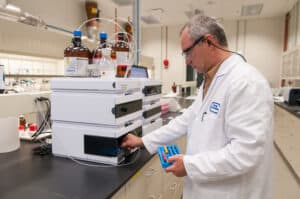
The chemical composition of a battery can be very delicate. The active materials within the cell work together in the energy releasing process and the choice of materials can determine the efficiency of the battery. However, undesired chemical reactions can also occur, affecting the safety and longevity of the cell. Different materials can cause unwanted results such as dendrite formation, short circuits and thermal runaway, and electrode degradation can be avoided or facilitated depending on the combination of materials.
The battery is made up of multiple parts; the main active materials are the anode, the cathode, and the electrolyte. Much of battery materials research focuses on testing materials for these components. Different materials have different advantages and disadvantages, alone, as well as in combination with other materials. In this article, we cover some materials being used or under research for the three key active materials.
The anode
The anode of the battery is the negative electrode, releasing ions to the cathode to create the electric charge. In a rechargeable battery, the anode becomes the positive pole during charging, collecting and storing ions to be released when needed.
The ideal anode is one that has high storage capacity and can maintain this capacity over time. Metal electrodes have been found to carry the highest number of ions; thus, in theory, pure metal is the most efficient anode material, as it provides a high energy capacity. However, they also can be highly reactive, making them difficult to work with. Lithium metal is one such example. One of the issues with li-metal is dendrite formation, a process where lithium composites unevenly on the surface of the anode, creating branch-like structures that can pierce the separator and cause the battery to short circuit.
Magnesium metal is another metal with a large theoretical capacity, but can be difficult to work with. Magnesium metal reacts with the electrolyte, causing the electrolyte to spontaneously decompose to form a solid electrolyte interphase (SEI) layer. This can occur in other battery compositions as well, but with magnesium this layer is ionically insulating, meaning the anode can no longer release or receive ions, essentially rendering the cell useless. In this situation, an anode-electrolyte combination that is not as sensitive would be more practical.
Graphite is seen as a favorable choice as an anode as it is abundant, naturally conductive, and does not present the problem of dendrite formation. It is currently a common anode material in lithium-ion batteries, but has not been as successful when paired with sodium or magnesium ions. A study has stated that this could be because they have the weakest chemical binding to a given substrate, leading to a lower energy capacity. This shows how while a material can work well in one instance, it might not work well in another.
The cathode
The cathode works in reverse of the anode. It is the positive electrode during discharge, receiving the ions from the anode, and it is the negative pole when charging.
Similar to the anode, an ideal cathode should have a high capacity, and, in a rechargeable cell, be able to reverse the chemical process without compromising the battery.
Cobalt is one material commonly used as the cathode in lithium-ion batteries; it provides a high energy density, which is why it is a popular choice. However, it has a limited temperature range and there are risks of thermal runaway. As it is a heavy metal, there are also numerous environmental concerns when it comes to battery disposal. Companies like Tesla are shifting focus to develop cobalt-free batteries.
Sulfur is a favored cathode material as it is abundant and has a high electrochemical potential. Sulfur, by itself, has low conductivity and is often mixed with conductive materials like carbon nanotubes to improve this issue. However, there is also a significant volume expansion problem. A study found that the sulfur cathode increased 170% after cycling. This causes a mechanical strain on the cathode, which could lead to cracks in its structure, greatly affecting battery performance.
Air, in combination with multiple materials, has been explored as a cathode alternative as well. The idea behind this is to use oxygen in the ambient air in the chemical process. Like sulfur, air has a high theoretical capacity. Depending on the material air is paired with, the drawbacks of air differ. Typically, the surface area of the substrate is proportional to the true capacity of the cell. However, in li-air cells, pore size has been found to be more important, as smaller pores can be clogged by lithium oxides precipitates that can form during the chemical reaction.
The Electrolyte
As the medium through which ions travel between the cathodes and anodes, the electrolyte is an important part of a functioning battery. However, it should be a passive part of the chemical process. Thus, an ideal electrolyte material should be conductive but not reactive. Since the electrolyte is in direct contact with the electrodes, unwanted chemical reactions can occur that would interfere with the performance of the battery.
Organic electrolytes are preferred because of their wide electrochemical window. This means that it can remain stable over a wide range of voltages without decomposing.
These electrolytes typically consist of a dissolved metal salt. However, since these materials are organic, they are subject to decomposition. The products and gases produced from decomposition can be toxic and compromise the integrity of the cell.
Organic electrolytes are also known to be flammable. Aqueous electrolytes address this issue. One type, water in salt electrolytes, has a wide electrochemical window and a higher conductivity than organic electrolytes. This could be a viable alternative for safer batteries.
Solid electrolytes are slowly gaining recognition as a possible substitute. Despite its theoretically lower conductivity, there are advantages to solid state batteries, including safety and the suppression of dendrite formation.
Conclusion
Battery materials should be chosen and optimized based on the application of the battery. Different cathode, anode, and electrolyte combinations may enhance one quality of the battery but compromise another. A battery that optimizes energy capacity may only be able to operate at a lower specific power, and in other cases this may be reversed. For instance, some applications, such as grid storage, may need a large energy capacity, whereas others should be optimized for power output. In many instances, these raw materials are often processed in order to reduce the occurrence of unwanted chemical reactions or loss of capacity. For example, lithium batteries often undergo pre-lithiation to compensate for the active lithium content that is lost in cycling. Graphite may also undergo a fluorination process to increase its surface area and overall battery capacity.
Researchers are constantly looking for the ultimate combination of battery materials in order to create safe, reliable, and durable energy storage solutions.
Reference: https://www.sciencedirect.com/science/article/pii/S2590049819301201

Learn how Arbin helps researchers test their battery materials.


